By William C. Peters
Anyone who has attended one of my apparatus purchasing classes or read one of my articles dealing with purchasing knows that I always point out that apparatus purchasing involves many choices, compromises, and trade-offs. For instance, when you specify a large water tank on a pumper, it generally involves raising the hosebed.
In this article, I will first identify the many areas in the general requirements (boilerplate) where your choices and decisions might impact the project. Then I will move on to the choices available when writing apparatus specifications using National Fire Protection Association (NFPA) 1901, Standard for Automotive Fire Apparatus, chapters as a guide.
Hopefully by the end of the article, you will have a much better understanding of the complex process you are undertaking.
BOILERPLATE CHOICES
NFPA compliance. The first statement your boilerplate needs to make is to require compliance to NFPA 1901 and to identify the NFPA classification of apparatus you are specifying. The choices are Pumper, Initial Attack, Mobile Water Supply, Aerial, Quint, Special Service, and Mobile Foam Apparatus. It is key that you make the identification, as this dictates the NFPA chapters that will apply to your purchase.
To better understand this, you could specify a pumper with an aerial device (such as a water tower), but it won’t be classified as a quint if it doesn’t have the necessary ground ladders. By the same token, you can specify an aerial apparatus with a fire pump and tank, but it won’t be a quint unless it has the necessary hosebed, 300-gallon water tank, and 1,000-gallon-per-minute (gpm) waterway on the aerial device (photo 1).
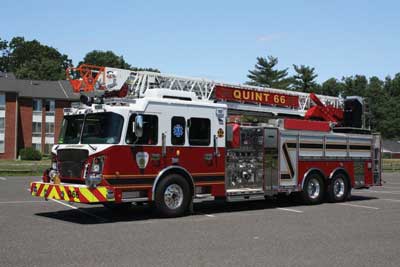 |
| (1) Is it a quint? It says it is, but does it have the required water tank and hosebed storage capacity? Simply meeting the five functions of a quint does not mean compliance with the standard. (Photos by Ron Jeffers unless otherwise noted.) |
Some choose not to comply with the NFPA standards, which I feel is a foolish choice. For instance, I have seen several pieces of apparatus that do not comply with the requirement for “yellow/red” reflective chevron striping on the rear of the apparatus. I have seen other noncompliant colors used because the purchaser “didn’t like” the red and yellow color theme. That might result in a serious problem if the apparatus is struck from behind and a lawsuit follows. What defense does the fire department have (photo 2)?
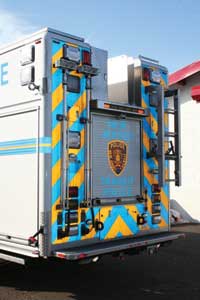 |
| (2) As a disclaimer, this is a police rescue truck and not required to be NFPA compliant, but it is an example of a noncompliant color combination of the required chevron striping. I have witnessed noncompliant chevron striping on several pieces of fire apparatus as well. |
Bid offer period. You must identify the number of days for which the bid must remain valid. In most cases, the bidders will not hold the price beyond 60 days. Don’t cut yourself short down to 30 days, which might require a rushed bid evaluation and recommendation.
Exceeding the NFPA standard. Will you accept the minimum compliance listed in NFPA 1901, or will some of your requirements exceed the minimum standard? If you intend to exceed the standard, indicate it in the specifications. For instance, you might intend to allow for 2,500 pounds of loose equipment where the standard calls for 2,000 pounds. Rather than have the bidder think that you misread the standard and take an exception, it is better to point this out up front.
Apparatus testing. What testing are you requiring for the new apparatus? Are you going to be satisfied with the testing and certification required in the standard, or do you have other expectations? If your response area includes extreme grades, you might require additional braking or engine power to negotiate the district. If you are more than 2,000 feet above sea level, the manufacturer needs to take that into consideration when certifying the pump.
Acceptance. Acceptance is identified as the time when the apparatus is released from the builder (or his dealer) to the purchaser. Where is acceptance to take place? Do you intend to accept the apparatus at the factory and drive it home, or do you want it delivered? I have witnessed many fire departments accept delivery at the factory, but there are several important considerations. Do all of the drivers have commercial driver’s licenses (CDLs)? A CDL may be waived in the state in which you work, but that does not necessarily include transportation from the factory. Do you have proper insurance coverage for the apparatus being transferred? How will you receive warranty service if the apparatus breaks down on the way? If you receive delivery at your location, all of these concerns are the manufacturer’s responsibility until the day the unit is delivered. I once had a custom pumper that was being transported from the manufacturer’s facility to the dealer for delivery when the front was damaged in an accident. After inspecting the damage, I refused delivery until a new cab was manufactured, installed, and reinspected at the factory.
The only apparatus I ever picked up at the factory was on 9/11/01. Since all commercial flights were grounded and I needed to get back to Jersey City, my salesman and I drove a pumper from Wisconsin back to New Jersey. It was an adventure that I never repeated!
Single manufacturer. Are you requiring that the apparatus cab, body, and chassis and possibly the aerial device be manufactured by one builder to ensure compatibility and serviceability and to eliminate divided responsibilities? This is a common statement in many specifications. You should realize that it shuts out many competent builders who purchase components such as the chassis or aerial device from other manufacturers. It is true that a single manufacturer can more easily handle warranty issues, but it certainly is a restrictive requirement.
Payment. What method of payment are you going to use? Do you intend to make a 100-percent payment on delivery and acceptance, or are you willing to make progressive payments during construction? You can save money if you elect to pay for components as they are made or delivered, such as paying for a commercial chassis, but this is not without risk. There have been many instances of purchasers losing their money when a manufacturer declares bankruptcy during the project and getting only pennies on the dollar after the court proceedings. If you do consider making any payments in advance, insist on “paid” receipts indicating that they are for the components, not just an amount due and paid and a balance. Another step that you can take to protect yourself is to get a performance bond. Some jurisdictions require this as a matter of course.
Bid bond. Is a bid bond required? What percent of the bid price must the bond cover? A bid bond simply ensures that the person bidding on the project will enter into a contract and supply the apparatus if awarded the bid. You may wonder why he wouldn’t. If there seems to be a large price difference in bids, the low bidder might have overlooked something or made a mathematical error when calculating the bid. This prevents him from withdrawing his bid without penalty. Bid bonds are typically for a percent of the bid price.
Performance bond. Is a performance bond required? A performance bond in the amount of 100 percent of the purchase price of the apparatus guarantees that you will receive the apparatus according to the provisions of the contract. If the manufacturer either goes bankrupt or defaults on the contract, the bonding company will guarantee that you will receive a comparable apparatus at the original bid price. The company might have to pay a difference, since in most cases it will be a year or more after the current contract, and inflation will certainly have caused a price increase. So, you may wonder, why wouldn’t you get a performance bond? The answer is cost. Each manufacturer purchases a performance bond at a certain rate per thousand dollars of cost. This rate varies from manufacturer to manufacturer based on the strength of the company and its past delivery history. The cost of the performance bond is passed on to the customer in the price of the apparatus.
Some purchasers who pay 100 percent on delivery feel that they don’t need a performance bond. There are two reasons you may want to rethink that position. As I said previously, inflation is one. If you have to rebid the apparatus after a year or more, it will certainly cost more. Second, in some cases, the performance bond can also cover the satisfactory application of the apparatus warranty.
Manufacturer’s reliability. Are you going to include a statement requesting that the manufacturer supply a list of other fire departments that have purchased a similar piece of apparatus from the manufacturer in the past? If so, are you going to check the references? Sometimes, purchasers include an artificial number that the manufacturer must have been in business for X number of years. Is a Dun & Bradstreet or other financial report required with the bid? Do you have anyone who knows how to interpret the report? These are all questions that you need to ask. Are these requirements included to actually qualify a bidder, or are they there to eliminate competition? I think requiring a user list is a legitimate request, and questioning the number of years the company has been in business could go toward establishing its reputation. I just don’t think that excessive requirements are justified.
Contingency stipend. Is a contingency stipend going to be included in your specifications and, if so, for how much? A contingency fund is a set amount of money to use for change orders that might be required at the preconstruction conference. When you specify a piece of apparatus, you walk a fine line between writing a generic specification that is fair to all bidders and getting what you need. A contingency fund will be helpful if the successful bidder recommends something other than what was in your specifications that will enhance the finished product or if the committee members happen to see something on another apparatus that they feel would add to the safety or efficiency of the purchase. As far as a sufficient amount, typically pumpers don’t require too many changes, but aerial and rescue apparatus are more apt to need tweaking. It is also important to indicate that a full accounting of the funds will be made and any amount that remains unused will be deducted from the final contract price.
If a contingency fund is not a viable alternative in your jurisdiction, another reasonable way to create some “wiggle room” is to specify more shelves, roll-out trays, or vertical dividers than you would usually need and use the credit for the unused items against the change order.
Product liability insurance. Do your specifications call for the manufacturer to carry some enormous product liability insurance policy? Is it necessary? For many years, this was an item that was included to eliminate competition. If one manufacturer had $10 million in insurance, another would get $15 million and include it in the proposal. Although I think that maintaining liability insurance is extremely important, I don’t think that the specifications need to say how much. Would it be better to require the bidder to maintain liability insurance and include a certificate from its insurance carrier showing how much insurance it carries and indicating that the purchaser be named on the certificate and that it will defend any lawsuits and assume liability for the use of the apparatus furnished under the contract?
I once had a bid where the manufacturer refused to disclose its liability insurance coverage. The bid was rejected based on that and other reasons. The manufacturer went out of business four months later. Apparently, the insurance coverage was one of the first things to go when funds became scarce.
Requirements for a factory authorized service facility. Having a facility that can honor warranty work and maintain the apparatus in a timely manner is extremely important. Do you set the requirements for the service facility? Some people put in a number of road miles from the service facility to the fire station as a requirement. Others require that the vendor respond to an out-of-service call within 24 hours. Do you describe how large the facility must be or how many mobile repair units it has? How about the number of mechanics working there and their qualifications? These are all questions that you need to answer to keep the apparatus in top condition. Just remember, a smaller shop with qualified personnel might do just as well servicing your needs as a huge shop with more people.
I think it is also important to include that the bidder or its service facility be responsible for towing the apparatus if that becomes necessary while under warranty. Some purchasers also require that the service center pick up and deliver the apparatus when it goes for service. With either of these requirements, it is critically important that the warranty facility have proper insurance coverage on the apparatus while in its care.
Delivery time. Most bids include a specific number of days in which delivery of the completed apparatus is required. Once again, is this number included because you need the apparatus in a specific time period, or is it there to eliminate competition? A more fair method of specifying delivery time is to state that the apparatus delivery is requested in X number of days, for instance 300 days. Then allow the bidder to include a firm number of days that it is comfortable with. Then you can evaluate whether the stated time is reasonable or excessive. It is even more important to allow the bidder to set the mark if a penalty for liquidated damages is included for late delivery.
Liquidated damages (penalty clause). Manufacturers dislike having a penalty clause included in the bid specifications, but I happen to think it is necessary. Without any financial implications, what would prevent a bidder from agreeing to your 300-day requirement and, when the apparatus is still incomplete after 400 days, just saying how sorry the manufacturer is? This tends to keep an honest person honest! I usually state that liquidated damages for late delivery MAY be made for late delivery. If there is a legitimate reason the apparatus might be delayed, I would rather have the manufacturer take its time and complete the project carefully rather than rush to make an artificial deadline.
Liquidated damages might also be assessed for an apparatus that is incomplete or not meeting the specifications when the final inspection is scheduled. In this case, you should include a “time to cure”—in other words, require that the apparatus be brought into compliance within 30 days or the contract will be rejected and the purchaser will move against the performance bond.
Factory inspection trips. First, let me state that it is my opinion that factory inspection trips at a minimum for a preconstruction conference and a final inspection are essential. Now the questions become, How many committee members are going on the trips? How many days are the trips to last? What costs are included—transportation, meals, and lodging? Most importantly, who is going to pay for the trips? If the bidder is expected to include the cost of factory inspection trips in the bid, all of these questions must be answered in the specifications.
Typically, three apparatus committee members usually are sufficient to perform the duties at a preconstruction or final inspection. Sometimes the committee will split up, and half goes to the preconstruction and the other half does the final inspection. That is okay as long as all of the preconstruction notes are fully understood by the final inspection team.
On an inspection that requires air transportation, I generally specify a minimum of three days: one day to travel to the location, one day for the inspection or meeting, and one day for the return trip. If it is a final inspection and the apparatus is complex or there is a multiple-vehicle order, you must allow more time as necessary.
Including the trips in the spec really leads to a “bumpy” playing field. One manufacturer located near a major metropolitan area can usually get airfares at a much more reasonable rate than one in an area serviced by a smaller airport. Costs of hotels can vary widely as well. One way to avoid this pitfall is to state that the bidder will not be responsible to pay for the inspections but will make all of the arrangements and the city or fire district will reimburse it for the actual itemized cost of the trips.
Approval drawings. Most manufacturers provide an approval drawing during the preconstruction conference and then update it after the meeting, showing any changes or modifications that were discussed. What other drawings do you want? One that I strongly suggest is a pump panel drawing. There are more purchasers disappointed with the layout of the pump panel after the apparatus is complete. Avoid this by requiring a layout drawing of the pump panel.
Another item that you might want to indicate is that the color coding and legends be provided by the fire department. If you have three pumpers from three manufacturers, it is unlikely the color combinations will be the same. Also, the NFPA descriptions of the discharges are only by number, so your finished pump panel will say: “Discharge #1, Discharge #2” and so on. If you are used to lettering such as “Right 2½-inch, Left Rear 2½-inch, Rear Hosebed” and so on, you should specify it. Sometimes this information is indicated on the pump panel approval drawing.
Equipment mounting. It should be indicated that the equipment supplied with the apparatus be mounted as directed by the fire department. Do you have other equipment you need mounted? Having the manufacturer or dealer mount equipment is a costly process. This is typically not in the specifications, but if it is, an accurate list of equipment must be included. Remember, the hourly rate for manufacturing custom brackets and the labor to install them can be very expensive.
One choice is to have the manufacturer install mounting surfaces in the compartments or on slide-out tool boards. Marine-grade varnished plywood or perforated aluminum plate spaced off the wall makes it easy to mount equipment with standard brackets. Another choice is to have commercially available mounting surfaces installed, then order the appropriate brackets that lock right into the tracks. Both choices will save significant money (photo 3).
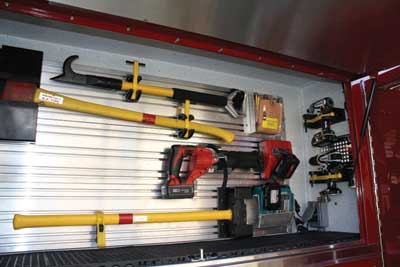 |
| (3) Having the manufacturer install commercial tool-mounting boards in the compartments will help the fire department with tool mounting. |
Apparatus dimensions. The overall size and weight of the finished apparatus should be of concern to your department. Do you have limitations on the height of the apparatus to fit in the firehouse or under overpasses? How about the length of the apparatus? Is the vehicle limited by the available space in the fire station? These are all items you must decide. If you have a length issue, you probably wouldn’t specify a top-mount pump or an extended front bumper. If height is an issue, a raised cab roof or a rear-mounted aerial device might create a problem. Consider these items carefully (photo 4).
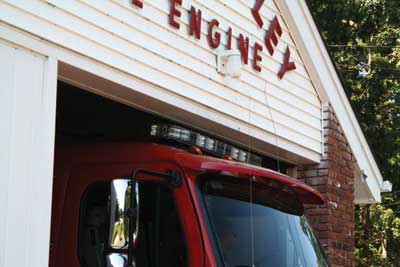 |
| (4) The overall length and height of the finished apparatus could be critical. |
Training. NFPA 1901 over the years has required “training,” then it went to “demonstrations,” and now it is not even mentioned! If you expect demonstrations or training, put it in your specifications. Now the decision becomes how many days of training do you expect? If yours is a career department with three or four shifts, you probably need to specify that many days. If yours is a volunteer department, you might want to specify evening or weekend training sessions. In addition, you need to tell the bidder if you expect chassis operation training, pump training, or aerial training. Is there any maintenance training required for the mechanical staff? Some departments have a “train the trainer” session where a few people receive the training and then qualify the others. It can get very difficult if a 25-member fire company shows up for driver training!
Warranty. What warranty period do you expect? For many years, one year was the standard warranty; if you wanted an extended warranty, it was extra. Just recently, several manufacturers have been offering a two-year warranty. Components such as the engine, transmission, axles, pump, and generator have “pass-through” warranties. They are covered by their manufacturer, but the warranty claim is handled by the apparatus builder. Some cities require a five-year warranty, which adds a very large premium to the price of the apparatus. I would suggest that you specify the standard two-year warranty and ask for pricing as an option for years three, four, and five. That way, you can compare the cost of extending the warranty period.
Also address in the warranty section who is going to do the warranty work. If towing is involved, who is going to pay for the towing? How long does the warranty center have to respond to out-of-service calls? Who is going to transport the apparatus to and from the warranty center? Again, how far away is it, and what are the mechanics’ qualifications? Many questions need to be addressed in relation to the required warranty and its application.
Documentation and service manuals. What manuals do you expect with the apparatus? Some of the choices are operator manuals, chassis maintenance manuals, parts manuals, pump manuals, aerial maintenance manuals, and electrical wiring diagrams. In some cases, you can choose to receive the manuals on a CD. In addition, some manufacturers have Web sites where you can look up parts.
As you can see, before we even begin to outline the requirements of the vehicle, there are many “boilerplate” choices to fully understand and discuss. Don’t just take a manufacturer’s spec and copy its boilerplate material. Chances are there will be more protection for the seller than the buyer.
One item that usually makes me laugh is the disclaimer language in the warranty section of the manufacturer-supplied spec. If I was writing the warranty section of the specifications, do you think that I would put in a statement such as, “This warranty shall not apply to apparatus that has been misused”? I doubt it!
Before we go over all the actual vehicle decisions you will have to make, there are a couple of “ground rules” laid out in NFPA 1901. It is important that you understand your responsibilities, the manufacturer’s/contractor’s responsibilities, and what the “Statement of Exceptions” means.
PURCHASER’S RESPONSIBILITY
It shall be the responsibility of the purchaser to specify the following details of the apparatus:
- Required performance above 2,000 feet or on grades greater than six percent.
- Maximum number of firefighters to ride within the apparatus.
- Specific electrical loads that are to be part of the minimum continuous electrical load.
- Any hose, ground ladders, or equipment to be carried that exceeds the minimums in the standard.
- If a trailer is being towed, whether it is Type I, II, or III.
After acceptance of the apparatus, the purchaser shall be responsible for ongoing training to maintain proficiency regarding the proper and safe use of the apparatus.
CONTRACTOR’S RESPONSIBILITY
The contractor shall do the following:
- Provide a detailed description of the apparatus, a list of equipment to be furnished, and other construction or performance details.
- Furnish a detailed description to include estimated in-service weight; wheelbase; turning radius; principal dimensions; angles of approach and departure; transmission; axle ratios; and, if applicable, the rated load of the aerial device.
- Furnish a detailed description of each aspect of the apparatus that is not fully compliant with the requirements of the standard.
- Provide specifications that define what it intends to furnish and deliver.
The responsibility for the apparatus and equipment shall remain with the contractor until they are accepted by the purchaser. In addition, the manufacturer has to supply either a statement that the apparatus fully complies with the standard or a “Statement of Exceptions.”
STATEMENT OF EXCEPTIONS
This is a statement specifically describing each aspect of the delivered apparatus that will not be fully compliant with the requirements of the standard and lists the following:
- The section of the standard for which compliance is lacking.
- A description of the particular aspect of the apparatus that is not in compliance or required equipment that is missing.
- A description of the further changes or modifications to be made to bring the apparatus into full compliance.
- Identification of the entity responsible for bringing the apparatus into compliance.
At the time of delivery, the Statement of Exceptions must be signed by both the manufacturer and the purchaser, indicating a mutual understanding and an agreement between the parties as to the substance thereof. In addition, an apparatus that is delivered subject to a Statement of Exceptions shall not be placed in emergency service until it has been modified as necessary and brought into full compliance.
Departments that think they are just going to waive the requirements of NFPA 1901 and place the apparatus in service are placing themselves in a very precarious position should an accident happen.
APPARATUS PROCUREMENT ISSUES Cab and Chassis
Cab and chassis issues. What type of chassis are you selecting for the apparatus? Will a commercial chassis fit your needs, or do you need a custom fire chassis? A commercial chassis is typically less expensive than a custom cab, but there are some limitations to consider. The engine horsepower (hp) selection is usually somewhat less than is available from a custom chassis builder. The space in the cab is usually smaller and able to hold fewer personnel than a custom. Many of the commercial chassis have the engine in front, which might result in a longer wheelbase and overall length (photo 5).
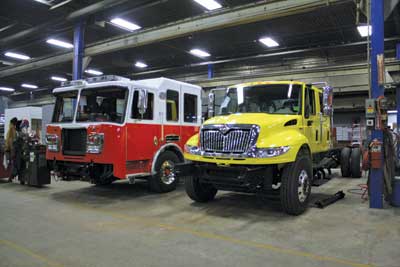 |
| (5) Are you specifying a custom or a commercial apparatus cab and chassis? |
Crew riding positions. If you are specifying a commercial chassis, the seating is generally two in the front and two or three against the rear wall. In a custom chassis, there are several more choices. Depending on how many riders you expect and any special cab compartments, the seating can be adjusted accordingly. Some extended cabs will allow for two in the front and eight in the crew cab. This is a crowded situation. You may choose to have two rear facing over the wheel wells and up to four against the rear wall forward facing. If you don’t expect that many riders, three against the rear wall allows for some “elbow room” to don your personal protective equipment and so on.
Some other configurations have compartments over the wheel wells and seating just against the rear wall. This will all be dictated by the number of firefighters responding, the size of the cab, and the amount of equipment you intend to carry in the cab. All equipment in the cab, including helmets, must either be in compliant brackets or secured inside a fully enclosed compartment.
Another seating position question that you must answer is, How many of the seats, if any, are going to contain self-contained breathing apparatus (SCBA)? What type of SCBA holding devices are you specifying? The standard calls for the apparatus to carry one SCBA and one spare cylinder for each assigned seating position (not fewer than four on a pumper), but it does not say that SCBA have to be stored in the seats. They can be mounted in compartments or some in the seats and some in the compartments. This is your decision.
Another decision is where to store the spare cylinders—in wheel well compartments or in side compartments, for example? Also, identify the brand and size of the breathing apparatus cylinders so provisions can be made (photo 6).
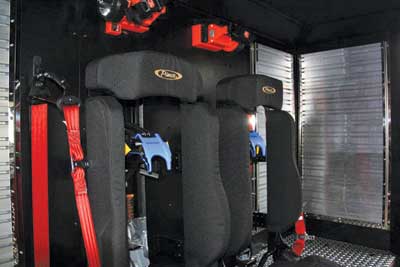 |
| (6) You must specify the number and type of SCBA seats in the cab. |
Cab design. Numerous cab designs can provide secure riding positions for all firefighters responding and their equipment. Some other cab design features are extended cabs and raised roof cabs. Extended cabs provide extra space for seating and compartmentation beyond the rear door. These cab extensions can be equipped with external compartments with outside doors. Typically, the upper portion of this type of compartment can be transverse under the rear seat riser for the storage of long items such as hooks. The outer ends of these compartments are handy for fire extinguisher storage and so on (photo 7).
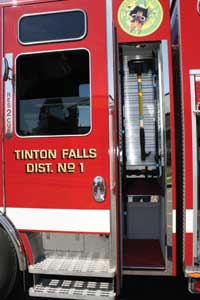 |
| (7) A cab extension will not only provide additional room for personnel in the cab but can also supply storage locations for tools and equipment. |
A raised roof is a nice feature for members riding in the crew cab so they can stand to exit the vehicle. Raised roofs can be from as little as six inches up to 20 or more inches. The limitation might be the available height inside your fire station.
Do you want any special cab trim features? How is the interior of the cab going to be covered—are you going to have padding, bed-liner type paint, stainless steel, or other extreme-duty material? What are the cab floors going to be made of—nonslip treadplate, nonslip rubber mat? Are special steps under the cab or special hand rails such as those illuminated with light-emitting diodes (LEDs) required?
What type of cab lighting are you expecting? Most use red/clear lighting in the cab. The red is supposed to preserve your night vision, but many wire the white lights to come on when the cab door opens! Specify the red lights to be door controlled. Are the lights going to be standard incandescent lights or LEDs? Do you want map lights for the driver and officer, and are they going to be mounted or “gooseneck” style? Are you specifying LED step and ground lighting? It costs a little more but is worth it both in reduced maintenance and reduced amp draw.
What type of cab doors and windows are required? Are you specifying full “long” doors that keep all of the steps out of the weather or shorter “barrier”-type doors that can open even when there is an obstruction next to the apparatus? Are you going to require manual crank or power windows in the doors? Is the glass to be tinted? Are LED warning lights required on the inner door surface to warn traffic that the doors are open?
Axle capacity. What front and rear axle capacity do you want? This is difficult for a person writing specifications. Some considerations are the size of the engine, the size and composition of the cab and body, the number of firefighters riding in the cab. how much equipment you intend to carry, water tank size, hose load, and if an aerial device is to be included. Typically, I put in the specifications that the axle and suspension capacities must meet or exceed the calculated in-service weight. This places the responsibility on the bidder. If the apparatus is overweight, it is the bidder’s responsibility to correct the situation before delivery (photo 8).
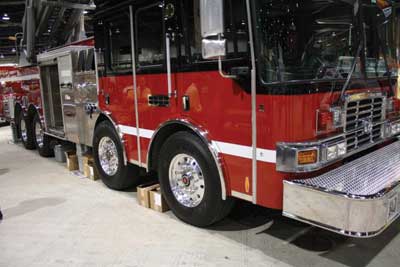 |
| (8) Some heavier aerial apparatus might require dual steering axles to reduce the individual axle load. (Photo by author.) |
Are there any special requirements for the power steering system? Do you require a tilt and/or telescoping steering column?
Front suspension. Do you want a standard front suspension or an independent front suspension (IFS)? IFS costs more than standard leaf springs, but it reportedly affords a better ride, better handling, and better stopping. There are several configurations of IFS, including torsion bar type, coil springs, and air bags. Research and make a decision on this.
Tires and wheels. What type of tread pattern do you want on the tires—highway tread, all-season tread, or possibly mud and snow tires on the rear? Do you have a special brand of tire that might be more serviceable in and suited to your location? What type of wheels do you want—steel-painted disc wheels or polished aluminum? Do you expect wheel trim like hub and lug nut covers?
Vehicle stability. How will vehicle stability be established? Methods available to the manufacturer are by tilt-table testing at a 26.5-degree angle while loaded, center of gravity calculations on the apparatus, or installing a stability control system. Most opt for installing a stability control system, which works in conjunction with the antilock braking system (ABS) to keep the apparatus stable.
Maximum top speed. The maximum road speed for apparatus over 26,000 gross vehicle weight rating (GVWR) is 68 miles per hour (mph). If the apparatus has a GVWR over 50,000 pounds or a combination of water and foam tanks that exceeds 1,250 gallons of liquid, the top speed is reduced to 60 mph. So, your decision as to how fast you can go will be dictated by weight and/or liquid capacity. Consider that a big-block diesel engine weighs considerably more than a mid-size engine and each seating position requires an allowance of 250 pounds for each location (plus the weight of the seat and so on), so you may have to put your engine on a “diet” if you want the top speed of 68 mph! Are you willing to compromise and carry less water to increase response speed?
Front bumper configuration. If the overall length of the apparatus is not a problem, an extended front bumper can serve many purposes. Do you want a front suction connection, a bumper trash line, a hydraulic or an electric reel installed, a winch, rescue tools, or possibly a bell? How is the hose going to be contained—with seat belt straps or a lift-up cover? Also, there are modifications that can be made such as tapering the ends for better turning and a painted steel bumper in place of a stainless steel type. There are lots of decisions to be made here (photo 9).
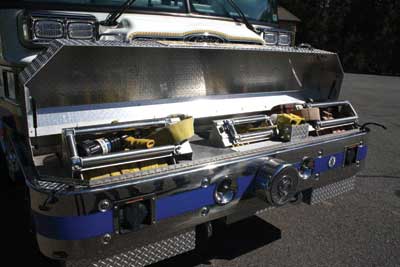 |
| (9) This front bumper extension contains two preconnected hose reels and a cord reel and serves as a mounting location for air horns, siren speakers, and a mechanical siren. |
Engine size. Diesel engines for fire service vehicles are typically mid-size engines, which are 350 to 450 hp, and big-block engines, which are 400 to 600 hp. In addition to the hp, the engine torque is the other measurement to consider. In most cases, a mid-size engine is generally ample to power the apparatus and drive a 2,000-gpm pump. Unfortunately, many people think, “If 450 hp is good, 550 must be better!” The problem is the cost of upgrading is not just that of a larger engine. When you go to the big-block series, it usually means that you will graduate to a larger cab. In addition, you will require a heavier transmission and driveline, not to mention the heavier weight on the front axle. Jumping from a 450- to a 550-hp engine could add in excess of $30,000 to the purchase. If you have extremely steep hills or an apparatus with a large pump and tank or aerial device, you might be a candidate for the bigger engine, but you really should evaluate your options. There are probably better options that the $30,000 could be used on than just to say you have a big engine.
While we are on the subject of the engine, do you want any special filter features? A fuel/water separator is a good option. Having valves installed in the fuel line to prevent loss of prime will help the maintenance mechanics when they have to change the fuel filters. Do you have any special air filter requirements? Some specify an air intake a specific number of inches off the ground for deep water operations.
Exhaust provisions. Where will the exhaust exit from? Most exits ahead of the right rear wheels away from the pump panel. On apparatus such as rescue trucks or hazmats, you may want to specify a vertical exhaust to carry fumes up and away from the body area (photo 10). Are there any special exhaust adapters needed on the end of the exhaust pipe for attachment to a station diesel exhaust removal system?
 |
| (10) A vertical exhaust stack might be required on hazmat, rescue, breathing air, or rehab apparatus to direct the diesel exhaust up and away from ground level. |
Auxiliary braking device. If the apparatus has a GVWR of 36,000 pounds or over, an auxiliary braking device is required. The available choices are electric driveline retarder, hydraulic driveline retarder on the transmission, engine compression brake, and exhaust brake. Which system works best for you? The electric driveline retarder works very well in conjunction with other systems on the apparatus, but it is more costly than the others and adds an element of weight. The hydraulic driveline retarder also works well but tends to heat the transmission fluid. This might not be a good choice in a warm climate. The compression brake turns the engine from an energy-producing power plant into an energy-absorbing air compressor by opening the exhaust valves before the cylinders fire. This is an effective braking device but it is noisy, which might be objectionable in residential areas. The exhaust brake also qualifies as an auxiliary braking device by restricting the exhaust. The choices all meet the requirement in the standard and vary in price. Research them to see which is best for you.
Fuel tank size. What fuel tank size is required? Does the fuel fill need to be on one specific side, or do you want a fuel fill on both sides? Is the diesel exhaust fluid (DEF) tank going to be near the fuel fill or in a different location?
Chassis dimensions. How much underbody clearance is needed on your apparatus? Do you intend to go off-road with it? What angle of approach and angle of departure are needed? The angle from the bottom of the tire to the lowest protruding part in front of or behind the axle is the angle of approach (front) and angle of departure (rear). The standard calls for a minimum of an eight-degree angle of approach and departure. If you have steep hills, these angles might need to be specified as being greater than eight degrees.
Are automatic tire chains to be installed on the rear axle? Where is the control switch for the chains going to be located?
Cab options and features. What special options and features are to be included? Do you need a backup camera? Is a commercial radio with weather band to be installed? Are provisions to install a computer or global positioning system (GPS) to be installed? Is a headphone type intercom system between cab riding positions to be supplied? Is it to have a radio interface to allow communications as well as intercom capabilities? Is an optional manual backup pump required for the cab tilt mechanism? There are many options and features available.
Mirrors. What type of rearview mirrors are required? The two primary types are the longer, rectangular shaped “West Coast”-type and the lower single-arm “bus-type” mirrors. Mirrors need to be adjustable from the driver’s seat. Do you want them heated as well? An additional mirror can be installed in the upper right front corner of the cab as a “look-down” mirror or possibly in front of the rear cab doors to allow the firefighters to see traffic approaching before opening the cab doors.
Radio provisions. Do you want the manufacturer to install communications radio antenna bases in the apparatus roof? This will help prevent future leaks that might result if an independent radio installer made holes in the cab. It also eliminates having to remove the headliner to install radio antennas. Having direct battery power, direct battery ground, and ignition switched power in the radio installation location will expedite the installation of the radios and avoid a possible warranty issue.
Battery installation. What type of vehicle batteries do you want? The apparatus manufacturer will provide adequate batteries for the chassis, but your maintenance department might have a specific battery type and rating that they prefer. Are remote jumper studs required? If so, where will they be located? Another choice you have to make is the type of battery charging system. Is an automatic ejection device required? Where do you want it located? Is the battery charger required to maintain a parasitic load such as 12-volt rechargeable handlights? If so, how many are to be included, and what is the amperage draw of each? Are any 110-volt accessories going to be wired to the shore line inlet besides the battery charger? If so, what is the amp draw? Do you need a larger shore line inlet, perhaps a 30-amp size?
12-volt and scene lighting. Is 12-volt scene lighting required? If so, I recommend LEDs for their excellent output and lower amp draw. Some specify a “brow” light over the windshield and others specify side cab lighting that can be switched on to look for an address or can be wired to come on with the door open. Is a 12-volt spotlight required? Some of the choices are the standard type that is typically installed in the upper cab corners, a handheld spotlight, and a remote-controlled light that is joystick-controlled from the dash.
Air inlet. Is a station compressor available to keep the air brakes powered? What type of air inlet do you want? Is an automatic ejection type required? Where should it be on the apparatus (photo 11)?
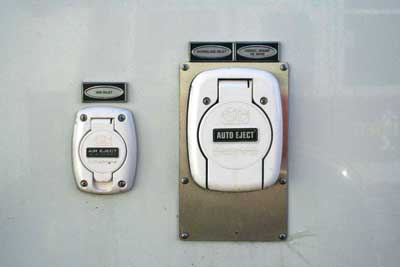 |
| (11) Auto-eject plugs for station air and electric are mounted side-by-side on this rig. |
Air horns. Are you going to require air horns? Is there a specific brand that you prefer? How will the air horns be activated? Some choices are from the steering wheel with a selector switch between the standard Department of Transportation (DOT)-required horn and the air horns, a foot switch on either side or both sides, and a dashboard switch for the officer. Avoid the “lanyard” that was popular when the horns were on the roof. You don’t want to encourage your driver to take his hands off the steering wheel to pull the air horn cord.
Sirens. Will the apparatus have an electronic siren, electro-mechanical siren, or both? Many feel that having both is good business, as one can serve as a backup if the other one fails. As for the electronic siren, does it need to have a public address system? What type of speakers are to be supplied, and where will they be mounted? How is the siren controlled—from the control box only, from foot switches, or with a horn button or dash button? The same questions apply to the mechanical siren. Is it to be mounted through or on top of the bumper? Where will the siren control or siren brake switch be installed?
Warning lights. I have written whole articles about warning lights on fire apparatus! The basic requirements are as follows:
- Apparatus divided into Zones A, B, C, D (A front, B and D sides, C rear).
- Apparatus divided into upper and lower sectors.
- Lower side lights every 25 feet.
- Two modes, controlled by parking brake:
- Responding
- Parked, blocking.
- Each zone has requirements for intensity and number of flashes in each mode.
- Colors: Red or Blue in any zone at any time; Amber prohibited front while responding, okay in any zone when parked; Clear prohibited while blocking any zone and to the rear while responding.
The manufacturer has to certify the warning light system on each apparatus by actual testing, mathematical calculations, or installing a “package” that is certified to meet all NFPA requirements by the lighting manufacturer.
So, understanding all of these requirements, the best thing to do is to look at various manufacturers’ product catalogs or online presentations and select a “package” that suits your needs. You can have one manufacturer’s lights in the upper zone and another manufacturer’s package in the lower zone or use one manufacturer’s products for the whole apparatus. Once the zones are satisfied, you can add as many lights as you desire. Although older-style lights might still be available, LEDs have by far taken over the industry (photo 12).
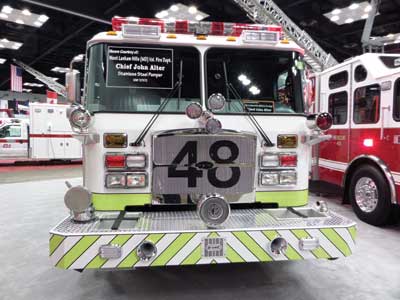 |
| (12) After one manufacturer’s lighting “package” is approved for the upper and lower zones, other warning lights can be added as desired. Here, two “Figure-8” lights and a Roto-Ray are installed on the front of the cab. (Photo by author.) |
Some questions that you will have to address are as follows: What colors are permitted in the state for fire apparatus? What manufacturer’s products are you going to select? Once you select a package, are you going to add lights? Where will the warning lights be controlled from? Are you going to add a traffic-directing arrow-type light to the rear of the apparatus?
In my experience, I think that warning lights and graphics are the two issues that generate the most excitement at the preconstruction conference!
BODY, COMPARTMENTS, AND HOSEBED
Body and compartment material (photo 13). What material is to be used in the construction of the body? Aluminum and stainless steel are probably the leading materials of choice. Galvanneal steel, composition, and poly-plastic bodies are also available. Each material has its own properties, advantages, and disadvantages. Aluminum is lighter than stainless steel and easy to work with, but the reaction between dissimilar metals, if not properly insulated, can cause corrosion. Stainless steel generally costs more than aluminum and is a heavier material. Stainless is probably the most rugged and rust-resistant material used in metal manufacturing. Galvanneal is steel that is coated with a zinc composition material to prevent rusting. Wherever galvanneal is cut or welded is prone to rusting if not properly recoated. Poly-plastic bodies are beginning to catch on in the fire service. The water tank can be integrated with the body and produced as one piece. The material is rugged and can be manufactured in many configurations. Research each type to help you make this decision (photo 14).
 |
| (13) Your selection of body material should be based on your research of what will best suit your department. |
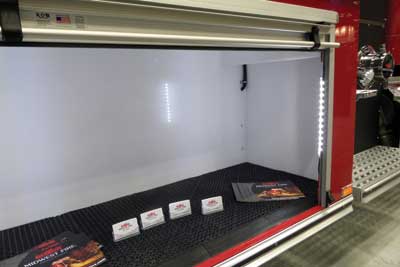 |
| (14) Poly-plastic bodies are becoming extremely popular in the fire service. (Photo by author.) |
Body layout. The body and compartmentation layout depends on apparatus overall length, wheelbase, and how the ladders are going to be stored. One choice is high side compartments on one side and low compartments on the other with ground ladders mounted above. Another configuration is high side compartments on both sides of the apparatus with the ladders stored on an overhead rack in a compartment through the water tank or behind the compartments on either side. Another decision is how deep to make the compartments. Most standard pumper configurations have deep (24-inch or more) lower compartments with shallow uppers. On units that must carry a large assortment of equipment, some specify deep lower and upper compartments. This takes up space for the water tank and hosebed and is a trade-off: deep compartments and a high hosebed or shallow uppers and a lower hosebed.
Most pumpers have a rather large rear compartment under the hosebed. The available height of this compartment is dictated by the size and configuration of the water tank and hosebed. Do you want dividers to separate the rear compartment from the side compartments, or do you want the space left open for the storage of long equipment across the body? Should the dividers be permanent and welded in place or bolted in for possible removal in the future?
Compartment doors. What type of compartment doors do you want—box pan, both vertically or horizontally hinged, or roll-up doors? Just like all compromises, box pan doors require space to open, so in an urban environment with parked cars next to the apparatus, this might be a problem. Roll-up doors require space at the top for the roller mechanism but fully open for you to retrieve equipment. If you use hinged doors, you might want to locate the hinge on the back side in the compartment next to the pump panel so the operator doesn’t have to step around the door to retrieve fittings and equipment. If you specify roll-up doors, are they to be painted job color? Is a protection panel needed to protect the door surface when it is rolled up?
What type of door hold-open devices do you require? Several designs have rods and springs; probably the most common is the gas shock type. Are key locks required on the compartment doors? Some departments want to be able to secure the equipment when the apparatus is parked and unattended.
Compartment lighting. Most compartment lighting is now LED strip lighting. This is a far cry from the older single incandescent light at the top of the compartment! There are some choices as to how many strips you want and where they are to be located. Also, LED strip lighting comes in various colors. You could still specify incandescent lights, but there is no reason to expend the extra amperage for lights that are not as bright or versatile (photo 15).
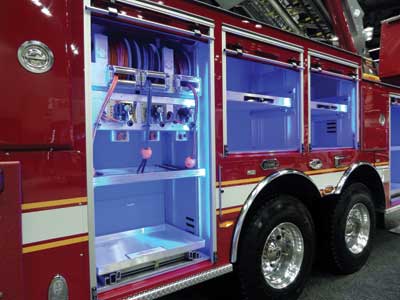 |
| (15) Blue LED compartment lighting is different. Clear and red LEDs are also available. (Photo by author.) |
Another consideration is the “Do Not Move Apparatus” warning in the cab that sounds when a compartment door is open. Do you have a specific type or style of light that you desire? What other equipment do you want wired to this warning—ladder rack, deck gun, or folding steps? Do you also want an audible alarm?
Compartment modifications. The manufacturer can offer many compartment modifications to make your compartments user friendly. Shelves, roll-out trays, roll-out/drop-down trays, vertical tool boards, swing-out tool boards, and vertical compartment dividers are just a few. Compartments can be divided into smaller compartments to hold various items. Cargo netting is helpful to keep items such as cribbing from sliding out of the compartment and jamming a roll-up door. Special compartments are available to hold SCBA air cylinders in racks, fire extinguishers, lifting air bags, saws, and hydraulic rescue tools. As mentioned previously in tool mounting, several mounting surfaces are available to line compartments, making it easier to mount tools and equipment. Prior to going to a preconstruction conference, committee members should sit down with a list of equipment and try to place it where they think it would best be stored. This will give you a very big advantage when the time comes to place shelves and so on (photo 16).
 |
| (16) Compartment modifications such as horizontal and vertical dividers, roll-out trays, and tool-mounting modifications provide orderly access to equipment. |
What type of floor liners do you want? Plastic tile material is the most common. It is important to keep the equipment off the compartment floor and to allow air to circulate around the tools. Some purchasers still specify varnished wooden slot material or formed aluminum grids similar to hosebed floors.
Body paint and trim. Specifications often state that the apparatus will be painted the same color as the previous apparatus. There are about a thousand shades of red (or whatever color you use)! Try to locate paint numbers from the previous purchase or review paint chips with the sales associate to match the color. As far as trim, do you want the front of the body compartments covered with aluminum treadplate to prevent paint damage? What type of rear step arrangement do you want, a full-depth running board type step or a more “flat-back” configuration? Where do you want steps and hand rails located? Are any pull-out steps needed?
What configuration of side step running boards do you want? Are there to be hose wells in the running boards for preconnected hydrant lines?
Pump compartment. Where will the pump controls be located—side pump panel, top-mount pump panel, or inside a compartment pump panel? If you are specifying a standard pump configuration, how wide will the pump compartment be? Some of this might depend on the equipment in the pump compartment such as a compressed-air foam system (CAFS). What type of panel material do you want on the outside surface—stainless steel or vinyl coated aluminum? Spray-on bed liner material is becoming very popular. It is nonglare, resists damage, and is quite durable (photo 17).
 |
| (17) Spray-on “bed liner” provides a rugged and long-lasting surface for the pump panel. |
Preconnected hose storage. Where will you store preconnected hoselines? What size hose is being used? What is the length of each line? Crosslays at the top of a mid pump panel are probably the most popular design. Do you have a special height above the ground that you want the hose to be loaded? Should it be in a single or double stack? Your typical deployment operation will dictate this. What kind of hosebed cover do you want—vinyl with a flap, hinged aluminum door, or straps on top and netting on the ends (photo 18)?
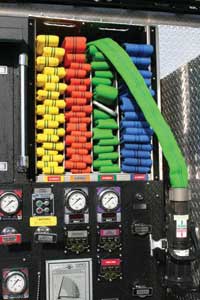 |
| (18) Crosslays are probably the most popular areas for preconnected hoselines. |
Another method of storing preconnects is speedlays. Typically the hose is loaded on trays and the trays are across the front of the pump panel, usually one above the other. The hose can be deployed in either direction, repacked on the tray, and the tray inserted in the space provided. Some have speedlays on roll-out trays for ease of repacking. What size hose and what length do you intend to carry in each speedlay compartment (photo 19)?
 |
| (19) Speedlays can be easier to load and bring the hose down to a manageable level. |
Another preconnect location could be the rear hosebed. Quite often a discharge is specified at the front of the hosebed for a preconnected line. Just be sure that there is enough room around the discharge to properly make the hose connection. Also, you must specify if you want the discharge at the bottom of the bed or near the top (photo 20).
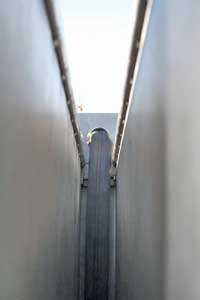 |
| (20) When specifying a hosebed preconnect discharge, be sure to indicate whether you want the discharge to be at the top or bottom of the hosebed. |
All hose storage must be secured against unintentional deployment.
Hosebed configuration and dividers. The hosebed configuration depends on several factors. The size and configuration of the water tank are the first consideration. A horizontal or “T” tank will result in a higher hosebed floor. A vertical tank at the front of the body will allow a lower hosebed that is not quite as long. If you specify a very low hosebed, be cautious when installing a number of hosebed dividers. In the wide area such as for large-diameter hose (LDH), a firefighter can get in the bed to assist with the loading. When you have full-height narrow dividers, it is much more difficult to load hose to the bottom (photo 21).
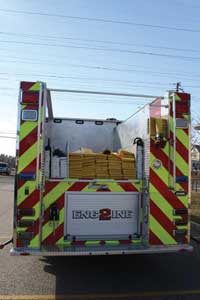 |
| (21) With a vertical or “L-shaped” water tank, a low hosebed can be specified. Be sure that the hosebed dividers are not too high, or it will be difficult to pack the hose. |
The standard only calls for 30 cubic feet of space for hose storage on a pumper. That is not very much! It is probably better for several reasons to describe in the specifications the hoseload that you intend to carry. Describe the hosebed from left to right, giving the diameter and length of the hose that you intend to put in each divided section of the bed. That will also determine the number of adjustable hosebed dividers you will need to properly configure the hosebed.
Anything special about the hosebed needs to be specified—such as leaving the hosebed walls unpainted or installing stainless steel trim on the inside near the ends to protect the surface. Also specify hosebed lighting.
Hosebed cover or containment. All hose storage must be contained to avoid unintentional deployment; the best way to accomplish this is with a hosebed cover. Several cover styles are available. One is a vinyl hosebed cover with a flap on the end that can be secured. If you want lettering on the cover, specify it. Another is a hard hosebed cover in a variety of styles. Hinged treadplate covers that you can manually lift and electric actuators to open the doors are available. Another type uses slats, much like a roll-up door, to cover the top and rear of the hosebed (photo 22). At a minimum, nylon strapping across the hosebed in several locations and a cargo net at the rear can help prevent accidental deployment.
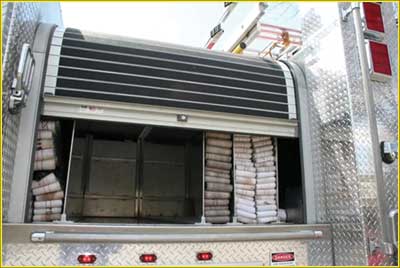 |
| (22) Hard hosebed covers can either be hinged treadplate doors or roll-up slotted material as shown here. |
Suction hose provided and storage. The standard requires that the manufacturer supply either 20 feet of suction hose with a strainer or 15 feet of supply hose. The supply hose can either be LDH or what was previously called “soft suction” hose. Which type of hose do you require? If it is hard suction hose, where and how will the hose be mounted? Some locate racks over the side compartments and others mount the suction hose to a ladder rack-type device. Compartments can be constructed to keep the hose out of the weather and available from the rear of the apparatus.
If supply hose is to be provided, where will it be stored—in a compartment, on the front bumper hose tray, or on the running board tray? These are just some suggested locations.
Ground ladders supplied and stored. The following ladders must be supplied on a pumper: one straight ladder with roof hooks, one extension ladder, and one folding ladder. It is up to the purchaser to specify the length of the ladders and their mounting locations. Typically a 14-foot roof ladder and 24-foot extension ladder are specified. If your district requires, you might specify a 28- or 35-foot extension ladder. Ladder storage can be in racks on the side of the apparatus, in a power ladder rack overhead, or in a compartment at the rear of the apparatus through the tank or behind the compartments. One of the most important considerations should be the ease of removing the ladders from the apparatus without strain or injury (photo 23).
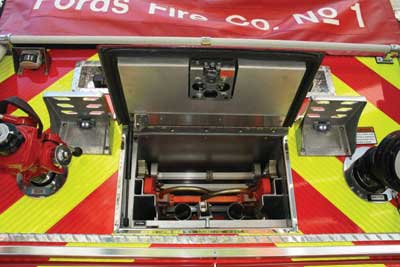 |
| (23) Water tanks can be designed with “through-the-tank” ladder storage specified. It places the ladders at a very manageable level. |
FIRE PUMP AND AUXILIARY PUMP
Fire pump. Do you require a single- or two-stage pump? The majority of the pumps in production are single-stage pumps. Today’s heavy duty diesel engines can easily satisfy the pump performance requirements with a single-stage pump. Two-stage pumps are more suited for applications where higher pressures are required such as supplying a standpipe in a high-rise building (photo 24).
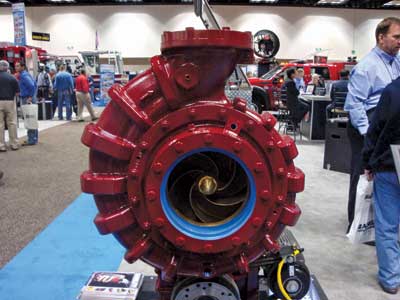 |
| (24) Single-stage fire pumps are predominantly specified because of their lower cost and easier operation. (Photo by author.) |
What pump capacity is required? Fire pumps are rated in 250 pound-per-square-inch (psi) increments; 1,500 to 2,000 gpm are typical on fire pumpers. Remember, the fire pump is rated at draft. When working from a positive source such as a hydrant, you can easily exceed the rated capacity.
How is the pump shaft to be sealed? The method that has been used for many years is a packing gland that requires periodic adjustment. Another method is a mechanical seal, which retains its adjustment and, unless it fails completely, is relatively maintenance free. Caution: The operator must not allow the pump to overheat, or damage to the mechanical seal might occur.
Pump drive. How is the fire pump going to be driven—split shaft transfer case, transmission power take-off (PTO), or a separate engine? The split shaft transfer case directs the power from the driveline to either the rear wheels or the fire pump. The PTO drive powers the pump from the transmission, which will also allow the apparatus to “pump and roll”—that is, engage the fire pump and the rear wheels simultaneously. Some smaller apparatus, like initial attack apparatus, might have a separate pump engine with the pump and tank module.
Pump pressure control. How is the pump pressure going to be controlled? Are you going to specify a standard relief valve that circulates water from the discharge side of the pump to the intake side or a pressure governor that controls the pump output by varying the engine speed? The majority of pumps use pressure governors in conjunction with the engine electronics.
Primer. What type of primer are you going to specify? For quite a long time, an electrically driven primer pump with an oil reservoir was the standard primer included on most apparatus. As time went on, the oil tank was eliminated and the primer worked only lubricated by the water in the pump. The latest is an air-operated primer that uses chassis air to create a prime in the pump for drafting. Research each type, and decide which primer suits your needs.
Size and location of discharges. How many discharges are you specifying for your apparatus? The standard requires enough discharges to move the capacity of the pump, with a minimum of two of them being 2½-inch. Prior to the use of LDH and large discharges, you could count the number of 2½-inch discharges, multiply by 250 gpm, and calculate the pump size. Now, purchasers specify discharges in various sizes all over the rig! When listing the discharges, specify the location and discharge size. Remember, each 2½-inch discharge can cost from $1,000 to $1,200, so determine if you are adding this discharge because it is necessary or for convenience (photo 25).
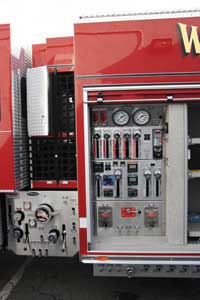 |
| (25) You must specify the sizes and locations of intakes and discharges. |
Other discharges could include a deck gun discharge, an aerial waterway, or a booster reel. If specifying a deck gun, you must describe the monitor, nozzle, any provisions to raise the gun out of the bed, and if it is to be remote controlled. If you specify a booster reel, where is it to be mounted? How much and what size hose will the reel contain? How is the reel going to rewind? Is a compressed air blowout valve required to evacuate the water from the reel?
Size and location of intakes. Where will the main pump intakes be located? Do they require built-in valves with relief valves and air bleeders? Are you specifying a front or rear intake, and is it valved? Is a front suction swivel required? What type of adapter is needed to attach a hydrant supply line? How many auxiliary (2½-inch) suctions are required, and what are their locations?
Types of intake and discharge valves and controls. Is a specific brand or style of intake or discharge valve required? What type of valve controls do you want—push-pull, electrically operated, or crank valves (photos 26 and 27)?
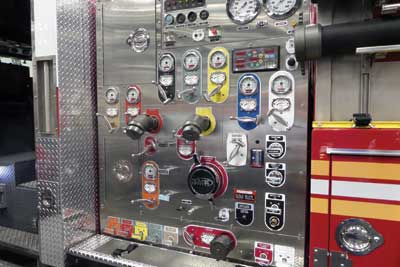 |
| (26) Various types of valve controls can be provided. This Fire Department of New York pumper has all crank-type valves. (Photo by author.) |
 |
| (27) Electrically operated valves allow the pump controls to be located away from the actual valve location. |
Drain valves. Do you have any special requirements for drain valves? Most apparatus use lever-type drain valves and a master pump drain. Some suction and discharge lines such as a deck gun or trash line might have automatic drains that expel the water from the line after use.
Gauges, flowmeters, and lighting. All discharges require a pressure gauge. Are you specifying standard analog gauges or electronic gauges? Are flowmeters required? Do you want stand-alone flowmeters or combination pressure/flowmeters (photo 28)?
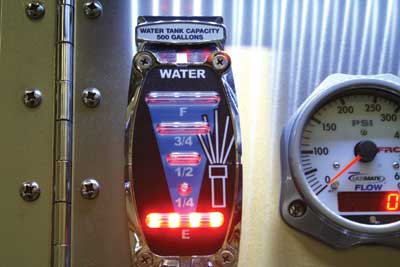 |
| (28) Dual reading pressure/flowmeters can be used to indicate both readings. |
Pump panel lighting is typically external lights, either incandescent or LED under a light shield on the outer face of the panel. Gauges can be backlit with LEDs of various colors. You might specify blue LEDs for water lines and red for foam discharges (photo 29).
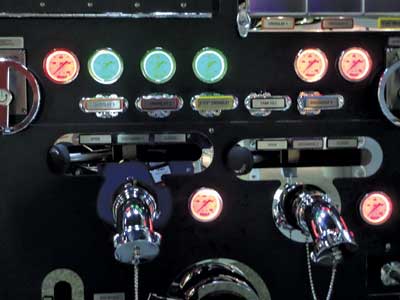 |
| (29) Color-coded, back-lit gauge lighting is available. (Photo by author.) |
Special controls and instruments on the pump panel. What special controls or instruments are required on the pump panel—an air horn activation button (to be used as an evacuation signal), auxiliary fuel gauge, switches for scene lighting, pump overheat alarm?
Auxiliary pump requirements. Is an auxiliary pump needed, and is it to operate independently or in conjunction with the fire pump? Some auxiliary pumps operate as a third stage for high pressure; others provide ultra-high pressure for low-flow, high-pressure booster lines.
WATER AND FOAM TANKS
Capacity, location, and construction. The minimum size water tank for a pumper is 300 gallons. Depending on the water supply situation in your district, you can specify larger tanks of 500, 750, or even 1,000 gallons. Many departments have the first engine start the operation on tank water while a water supply is established. Just remember, the size of the water tank will have a large impact on hosebed design, compartment space availability, and top speed of the apparatus.
The vast majority of the apparatus purchased today have poly-plastic water tanks, which have just about eliminated water tank leaks; most have a lifetime warranty.
If you are including a foam tank, will it contain Class A or Class B foam? Is there going to be a foam cell within the water tank? Will it take away from the water tank capacity?
Tank level indicators. What type of water and foam tank level indicators do you want? Panel-mounted LEDs are pretty much the normal selection now. Are auxiliary tank indicators required on the cab? Will they be on all the time, or will they just illuminate when the pump is engaged? Do you require any remote indicators in the cab or at the rear of the apparatus?
Flow and fill rates. What flow rate do you expect from the tank? How large will the tank-to-pump valve be? What fill rate do you expect? What size tank fill valve needs to be provided?
Dump valves and direct tank fills. If the unit is a mobile water supply, what type of dump valves do you want? Are they to be air operated or manually controlled? Will a single dump at the rear, with a chute to the side, work for you? What size direct tank fill is needed, and what kind of valve should be provided?
AERIAL APPARATUS
Type. What type of aerial device are you considering purchasing? The choices are below.
Straight Stick Aerial
- Lower purchase cost than platform-style apparatus.
- Can generally be kept smaller and more maneuverable than a platform device.
- Provides a continuous means of egress for firefighters operating on upper floors or the roof of fire buildings.
- Versatile—can be used as a ladder or an elevated stream device.
- Simple to set up and operate.
- Available in a multitude of operating lengths and operating load capabilities.
- Lighter in weight than platform-style apparatus.
Aerial Ladder Platform
- Provides a stable work platform for firefighting and rescues.
- Generally has higher water flow capability than a straight aerial.
- Provides a continuous means of egress similar to a straight aerial.
- Has high equipment and personnel load capability at platform (dry 750-pound minimum vs. 250-pound minimum).
- Sometimes requires more area for setup than a standard aerial because of increased outrigger footprint.
- Dimensionally larger and heavier than straight aerial ladder apparatus.
Articulating Platform
Some of the original platforms were articulating only.
Telescoping-Articulating Platform
The telescoping-articulating boom platform is basically an enhancement of the telescoping boom aerial device. The main booms telescope for height, and an articulating end section of the device allows increased operating range and flexibility. It also makes the unit much more complicated and expensive compared with traditional devices (photo 30).
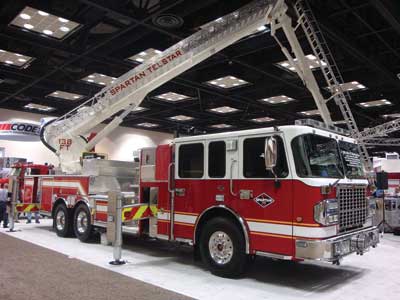 |
| (30) This aerial apparatus telescopes and has an articulating arm on the end, which is very handy for reaching over parapets. (Photo by author.) |
A platform apparatus is heavier and, depending on where it is to be used, could require extra axles to carry the weight.
Water Tower
Water towers range from simple units in the 50-foot range to complex units with three or more booms that extend up to 130 feet in height (photo 31).
 |
| (31) The articulating water tower on this pumper allows for elevated master stream placement. |
- Elevated streams can be placed on relatively small pumper chassis without altering the pumper design dramatically.
- Smaller devices do not add excessive weight to the vehicle.
- Lower costs are associated with a basic water tower than aerial ladder or aerial platform apparatus.
- A ladder mounted to a water tower can be used for rescue.
Mounting location. Where will the turntable be located? The terms rear-mount, mid-mount, and tiller-mount, when related to aerial apparatus, refer to the mounting location of the aerial turntable. The following are some of the advantages and disadvantages of each mounting location.
Rear-Mount Advantages
- Reduces the overall length of the apparatus.
- Reduces overhang behind the rear axle.
- Generally has increased body compartment availability.
- Has a greater area for operating at low angles, off each side, and off the rear.
Rear-Mount Disadvantage
- If you “nose in,” you have less reach to the front.
Mid-Mount Advantages
- Lower travel height (photo 32).
- Good frontal visibility.
- Weight balance on axles is generally good when a pump and water tank are on the vehicle.
- Easier to “spot” the turntable than with rear-mounts.
 |
| (32) Mid-mount aerials and platforms have low travel heights, which is extremely valuable in areas with low fire station doors. |
Mid-Mount Disadvantages
- Vehicle cab blocks low-angle operations in the front of the apparatus.
- Ground ladder storage is sometimes a problem.
Tiller-Mount Advantages
- Increases apparatus maneuverability.
- Increased compartment space on trailer.
- Lowers the travel height of the vehicle.
Tiller-Mount Disadvantages
- Increased overall length of the apparatus (beyond 50 feet).
- Requires two well-trained operators.
- Increased cost.
Aerial height and reach. The minimum vertical height of an aerial device, according to NFPA 1901, is 50 feet. What vertical height and horizontal reach do you need for your apparatus? Are there limitations on the stabilizer configuration or spread? If you are specifying a water tower, will a rescue ladder be attached? Do the hand rails need to fold down to reduce travel height?
Water delivery (photo 33). If specifying an aerial ladder, will it have a prepiped waterway or a portable ladder pipe? If a prepiped waterway is specified, does it need to be “pinable” to the tip or third section of the ladder? What type of monitor and nozzle are required? Is the monitor to be remote controlled from the turntable? How is the waterway going to be supplied? Are any hose outlets required at the tip or in the platform? Is a hose storage box required at the platform? If a platform is specified, how many monitors are required, and what are their make and configuration? If you specify a water tower, what types of monitor and nozzle are required? Where is it to be controlled from, and how is the waterway to be supplied (photo 34).
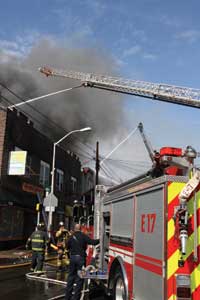 |
| (33) Your aerial apparatus is required to have either a prepiped waterway (left) or a portable ladder pipe (right) for elevated stream application. |
 |
| (34) This platform has two monitors and two hose discharges at the platform location. |
Other aerial apparatus features (photo 35). Is a breathing air system to be supplied with the aerial apparatus? How many supply cylinders and what operating pressure do you require? Is a mask box required in the platform? How many air outlets are required? Is an air outlet required at the tip of an aerial ladder? Are an air outlet and mask box required at the turntable? What type of low-air warning device is to be supplied? What equipment do you want mounted at the tip of the aerial ladder or in the platform—an ax, a halligan, a hook, a roof ladder? Are any special platform attachments required for a litter transport such as rappelling arms or a roof ladder attachment? Are aerial sign plates required (photo 36)?
 |
| (35) Breathing air is not required, but if it is specified the standard outlines the requirements. |
 |
| (36) The firefighter is removing a mounted attic ladder from the tip of the aerial for use on the roof. |
Aerial lighting (photo 37). How do you want to illuminate the climbing area of the aerial—with spotlights at the bottom or LED rope lighting? What kind of lighting do you require at the platform or at the tip of the aerial—12-volt LED scene lighting, line voltage lighting, or spotlights?
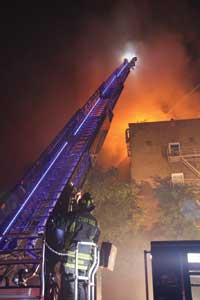 |
| (37) LED lighting on the aerial climbing surface is extremely popular. |
FOAM SYSTEMS
What type of foam system are you specifying? The basic choices are as follows:
- In-line eductor.
- Self-educting master stream.
- Around-the-pump proportioning system.
- Balanced pressure proportioning system.
- Direct-injection foam system.
Do you have a specific after-market brand of foam system that you require?
Foam type. What type of foam are you going to employ with the system—Class A, Class B, or both? How much of each type of foam will be carried in foam tanks?
Foam system features. What discharges are to be foam capable? What is the required flow from each? What proportioning rate (in percent) is required? What are the hose length and size being connected to the foam discharge? Is an outside foam pickup required? Is an automatic foam refill system that allows filling of the tanks from the ground required? What are the features of the system you desire (photo 38)?
 |
| (38) If a foam system is specified, all of the required controls need to be spelled out. |
Compressed air foam systems. Are you specifying a compressed air foam system? If so, what is the standard cubic feet per minute (cfm) rating of the air compressor required? What type of compressor is desired? What system controls are required? What type of wet/dry control is required? Is an airflow meter required? What discharges are going to be supplied by the foam system?
LINE VOLTAGE ELECTRICAL SYSTEMS
Is a line voltage electrical system required? If so, what is the power source going to be, and what voltage/amperage is required? Types of power sources are as follows:
- Portable gasoline generator.
- Hydraulically driven generator.
- Direct drive (PTP) generator.
- Auxiliary engine (diesel usually) generator.
- Belt-driven generator or alternator.
- Supplied by the apparatus 12-volt system.
Of these power sources, is there a specific brand you desire? Where will the unit be located on the apparatus? Where will the panelboard (circuit breaker panel) be located? Where will the generator controls be located?
Receptacles. Supply the quantity, amps/volts rating, style of receptacle, and location for all receptacles on the apparatus.
Remote-controlled circuits. What circuits require 12-volt remote control? Scene lights? Receptacles that power removable scene lights? Power for a hydraulic rescue tool pump?
Line voltage scene lighting. Indicate the style/make, location, voltage, wattage, type of bulb, and mounting for any scene lights to be mounted on the apparatus. Are any of the scene lights going to be on removable tripods? Do the scene lights need to be the bottom raise variety? Are the scene lights to be switched from the cab or pump panel?
Is a power-operated light mast required (photo 39)? What make and model of light tower do you desire? How high must the tower extend above the apparatus? How many lights and what type of output are desired? What configuration of tilt and pan of the light heads is required? From where is the light tower to be controlled—the pump panel or a remote tether?
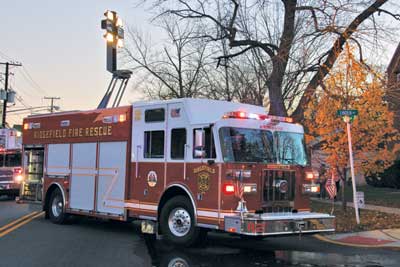 |
| (39) This power-operated light tower can increase fireground safety by providing illumination. |
Cord reel information (photo 40). Do you require cord reels on the apparatus? How many? Where will they be mounted? What voltage/amperage needs to be available from the reel? How many feet of cord will be supplied? What type of distribution box is to be provided, and what is the outlet configuration required? What type of rewind system is needed?
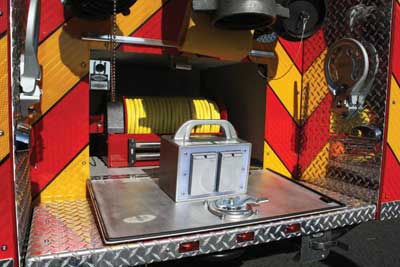 |
| (40) If you specify a cord reel, outline the size of the cord, length, and terminating distribution box. |
Shore line power. Are any of the receptacles to be powered both by the shore line and the generator? If so, which outlets, and what is the expected amp draw?
COMMAND AND COMMUNICATIONS
Does the apparatus require a command and communications area? If an enclosed command or communications center is required, what is the approximate size, in area, required for this function? How many people will occupy the command center? Will the command center require permanent seating or folding seats that can be stored? Are there any special lighting requirements? What communications equipment is required? Are computers or other equipment such as video monitoring or televisions required?
AIR SYSTEMS
Is the apparatus required to have an air system provided and installed?
Air system functions. The following are the functions of an air system that might be available for installation on your apparatus:
- Refill SCBA cylinders.
- Supply remote breathing air.
- Supply remote high-pressure breathing air hose.
- Supply utility air.
Air system types. The following types of air supply systems are available:
- Stored air cascade system—How many storage cylinders are to be supplied on the apparatus? What type are they to be (for example, Department of Transportation)? What is the pressure of the storage system? How many SCBA cylinders do you expect to fill? What size are the cylinders being refilled? To what pressure must the cylinders be filled?
- Cascade system with booster pump—All of the questions about the cascade storage apply in this category as well, plus the following: What type of booster pump do you desire? What is the operating voltage of the booster pump? Is the booster to have a low-/high-pressure selector?
- Onboard air compressor—Is a compressor required? What is the free air delivery rating in cfm at the specified psi? Where will the compressor be mounted? What is going to power the compressor? Where will the compressor controls be located? What ambient temperature will be expected if beyond 32ºF to 110ºF?
Fill station (photo 41). If you are filling SCBA cylinders with the apparatus air system, a fill station is required. What type of fill station do you want? How many cylinders will be filled at one time? Where will the fill station be located? How many refill lines are required?
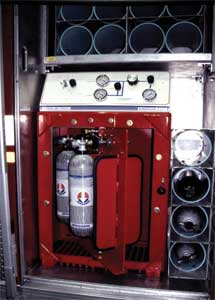 |
| (41) If you intend to fill SCBA cylinders from a cascade or compressor on the apparatus, a fill station is required for safety. |
Air hoses. Are any types of air supply hoses required? What discharge pressure and cfm flow are required? Will the air line supply breathing air or utility air? How many feet of hose are required? Are air reels to be supplied? What are the reel mounting location and rewind type? What kind of fitting or connection is required at the end of the hose?
WINCHES
Is a winch required? Is it to be a permanently mounted type or a portable winch that is used with receivers around the apparatus? What winch capacity is required? What is the power source for the winch, electric or hydraulic? What are the winch locations? What type of control is needed for the winch? Are “rope tie-off eyes” required if you are specifying receivers (photo 42)?
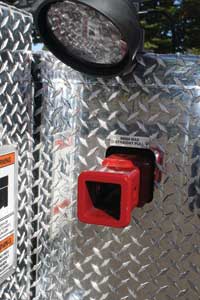 |
| (42) Specify the location of portable winch receivers. |
TRAILERS
Is a trailer to be towed under emergency conditions? What type of trailer is being towed?
- Type I (remains connected).
- Type II (operates at the scene with independent power).
- Type III (transport only).
What are the purpose and function of the trailer? What will the trailer carry? List equipment or total weight. What type of tow hitch is required? What type of electrical connection is required for the trailer lighting?
The purpose of this article is to stimulate your thinking and to make you aware of the many choices, compromises, and decisions you will have to make when you are specifying a piece of fire apparatus. I strongly suggest that you obtain a copy of NFPA 1901, Standard for Automotive Fire Apparatus, and review both the requirements in the body of the standard as well as the explanatory material in Annex A.
This is a long, arduous process. If you do your research, you will be well prepared to rise to the challenge. Best of luck with your apparatus purchasing!
WILLIAM C. PETERS retired after 28 years with the Jersey City (NJ) Fire Department, having served the past 17 years as battalion chief/supervisor of apparatus. He served as a voting member of the NFPA 1901 apparatus committee for several years and is the author of the Fire Apparatus Purchasing Handbook, the apparatus chapters in The Fire Chief’s Handbook, and numerous apparatus-related articles. He is a member of the Fire Engineering and Fire Apparatus & Emergency Equipment editorial advisory boards and of the FDIC executive advisory board.
Fire Engineering Archives

